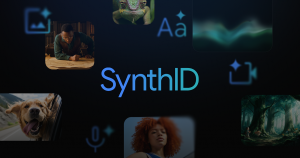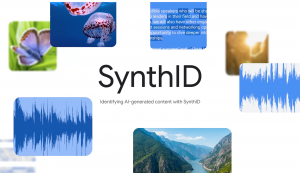Last updated on September 17, 2025
SynthID Detector: A Guide to Detecting AI-Generated Content
Learn what Google’s SynthID is, how it works, and how to detect AI watermarks in digital content.
Artificial intelligence is changing how we create and consume information. A few years ago, AI tools were mostly experimental or niche. Today, they are everywhere—writing essays, generating marketing materials, producing images, composing music, and even creating videos. This growth has blurred the line between human-made and AI-generated content. The possibilities are exciting, but the risks are real. Misinformation, fake media, and academic dishonesty are only some of the issues that emerge when content origins are unclear.
To address this challenge, Google DeepMind introduced SynthID. It is a watermarking and detection tool that embeds invisible identifiers into AI outputs. Unlike visible labels, SynthID works at the data level. It places hidden signals in text, images, audio, and video. Ordinary users cannot see them, but specialized tools can detect them later. This means content can circulate freely online while still carrying a hidden mark of origin. In doing so, SynthID makes AI content more transparent and traceable.
What Is SynthID?
SynthID is Google DeepMind’s solution to the need for content authenticity in an AI-driven world. It is a watermarking and detection system that identifies AI-generated content. Unlike traditional watermarks that appear as logos or text overlays, SynthID is invisible. The watermark is embedded directly into the content itself.
Google already uses SynthID in advanced products. Gemini uses it for text, Imagen for images, Lyria for audio, and Veo for video. These integrations show its flexibility. No matter the medium, SynthID embeds a durable signal that reveals machine-made content.
To extend its use, Google released the Detector portal. Users can upload files to check for watermarks. This makes verification easy for both technical and non-technical users. With this step, SynthID bridges the gap between innovation and real-world application.
How SynthID Works
The science behind SynthID is simple yet complex. At a high level, it embeds a signal into content. The signal does not change how the content looks or sounds but can be retrieved later by detection tools.
For text, it may involve subtle word patterns. For images, the signal is woven into pixel arrangements. In audio and video, it becomes part of waveforms and frame structures.
What makes this remarkable is its invisibility and resilience. A reader can view an image or listen to audio without noticing anything unusual. The watermark is also durable enough to survive small edits. Cropping, compressing, or paraphrasing usually will not remove it.
However, it has limits. Heavy edits like translations, filters, remixes, or major restructuring can weaken or erase the watermark. This shows that SynthID is not foolproof. Instead, it is best seen as one tool in a larger system for ensuring content authenticity.
Limitations of SynthID
While SynthID represents a major leap forward, it comes with two significant limitations that need to be acknowledged.
First, there is editing sensitivity. Watermarks can survive small edits but not heavy transformations. A rewritten article may lose its watermark entirely. A spliced video with effects may also degrade the signal. This makes it more of a deterrent than a guarantee.
Second, there is no universal standard. Google has SynthID, but other companies are building different systems. Without global standards, the ecosystem remains fragmented. Some AI-generated content will be traceable, while other pieces will not. Collaboration and policy are needed for wider trust.
Detecting SynthID Watermarks in Text
For researchers, educators, and developers, SynthID provides several pathways for detecting watermarks in text-based outputs.
One option is Hugging Face Transformers, which includes an experimental Bayesian checker. While not production-ready, it lets developers test watermark detection in practice. Organizations can also build custom tools. These allow them to detect watermarks in outputs from their own AI systems. This offers flexibility for specific workflows. Finally, there is Google’s SynthID Detector portal. Users can upload files to confirm if watermarks are present. This is the simplest method, especially for non-technical users.
Why SynthID Matters
SynthID is more than a technical solution. It is also a safeguard in a world where AI can undermine trust in content.
- In education, SynthID helps schools maintain academic integrity. Students may use AI to generate essays or assignments. Educators can use this to check authenticity beyond plagiarism detectors.
- In journalism, SynthID helps fight misinformation. Fake images and videos spread quickly online, shaping public opinion or fueling conflict. Journalists can verify visuals with it and protect audiences from deception.
- For businesses, SynthID protects brands. Fake press releases and AI impersonations can harm reputations. Watermark detection ensures that official communications can be verified.
In policy and governance, it aligns with laws like the EU AI Act. This act calls for transparency in AI use. it shows how companies can support ethical and legal standards.
Conclusion
SynthID is an ambitious attempt to bring trust and accountability to AI-generated content. By embedding invisible watermarks into text, images, audio, and video, it gives creators and users a way to verify authenticity. It has flaws. Heavy editing can weaken watermarks, and the system remains tied to Google’s ecosystem. Still, it sets a precedent for the future. As AI evolves, distinguishing authentic content from synthetic will only grow more important. it is a step toward that goal. It shows that innovation must come with responsibility. While not yet a universal standard, it lays the foundation for trustworthy digital content in the years ahead.
References
- https://deepmind.google/science/synthid/
- https://deepmind.google/discover/blog/identifying-ai-generated-images-with-synthid/
- https://www.datacamp.com/tutorial/synthid
- https://techcrunch.com/2023/08/29/deepmind-partners-with-google-cloud-to-watermark-ai-generated-images/




















